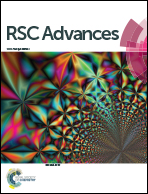Photophysical property vs. medium: mononuclear, dinuclear and trinuclear Zn(ii) complexes†
Abstract
Three complexes [Zn2(L)2(μ1,2-OAc)(μ1,1-OAc)]·C9H8N2 1·C9H8N2, [Zn3(L)4]·(ClO4)2 2 and [Zn(L)2]·CH3OH 3 were synthesized using a common Schiff base 2,4-dimethyl-6-((quinolin-8-ylimino)methyl)phenol (HL) and characterized by various methods such as elemental analysis, 1H NMR, FT-IR, UV-Vis and mass spectroscopy. The single crystal XRD analysis revealed that complex 1 is dinuclear, complex 2 trinuclear and complex 3 mononuclear in nature. The photophysical properties of the ligand and complexes were also investigated by different techniques such as UV-Vis spectroscopy, fluorescence spectroscopy, fluorescence lifetime measurement, DFT, and TDDFT calculations in solvents of different polarity. The complexes exhibited higher quantum yields than the ligand in solution. The trinuclear complex had higher emission intensity than the mono and dinuclear complexes in solution as well as in the solid state. In addition, complex 1 exhibited a unique dissymmetric coordination mode of the oxygen atom in the acetate bridging moiety.


 Please wait while we load your content...
Please wait while we load your content...